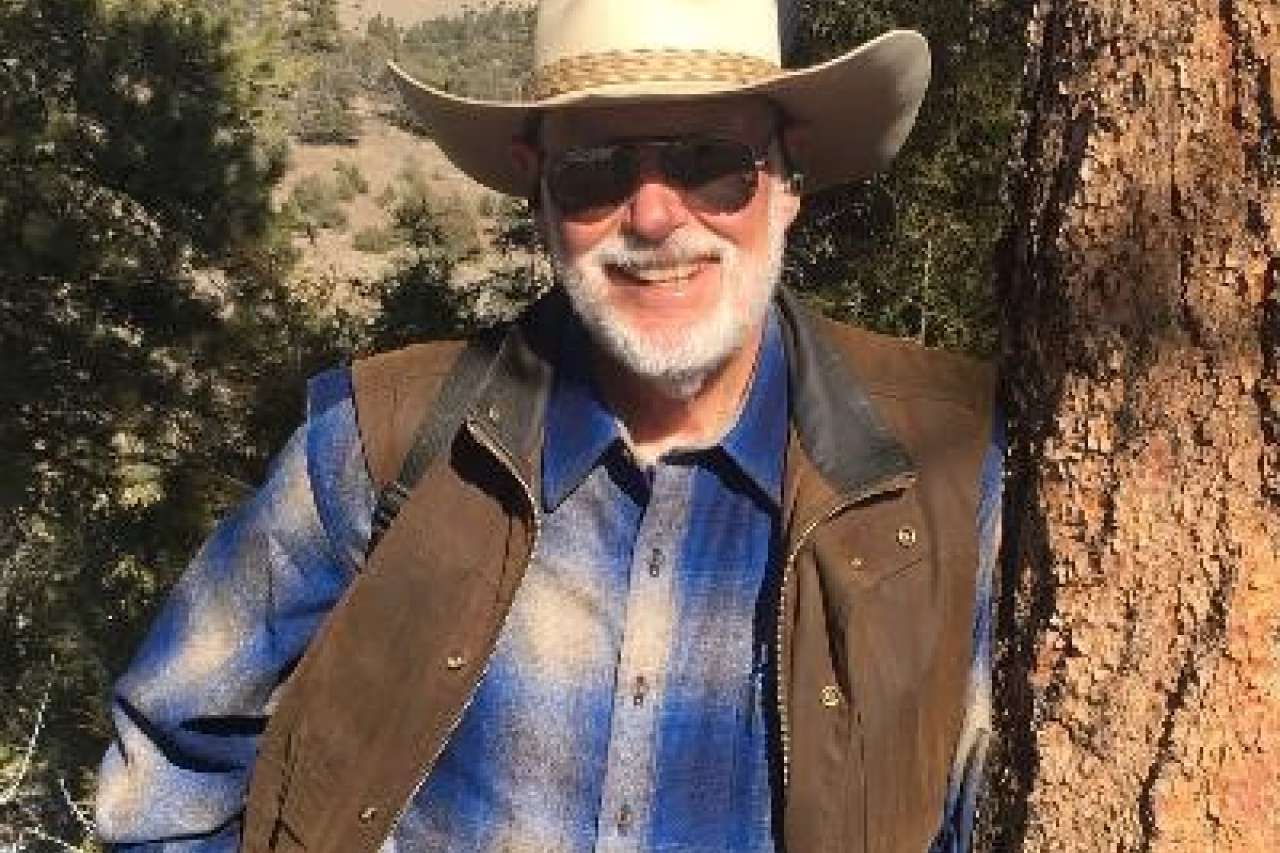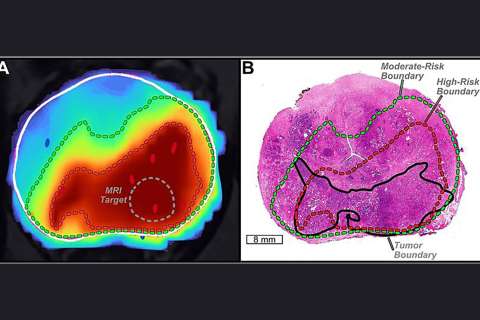Quality of life is paramount for Dr. Thomas McWilliams.
After retiring in 2018, the former medical school dean has been caring for livestock on his 160-acre ranch in remote Colorado that he shares with his wife of 54 years, DeLoss, a professional artist.
“Dr. Mac,” as he was known during his 41-year career as a clinician and academic, does cool stuff like weeklong camping and hunting treks with his trusty mule, Drifter, and river-rafting in Alaska, where he began practicing emergency and family medicine in the 1970s, including providing free care to sick and injured residents of the Alaskan Peninsula and Kodiak Island.
So, when McWilliams, DO, was diagnosed with intermediate-grade prostate cancer in late December 2023, he pursued the most effective treatment with the fewest side effects.
And that’s precisely what he received at UCLA Health, thanks to the recommendation of one of his two sons, Justin McWilliams, MD, section chief of Interventional Radiology at UCLA Health.
Dr. Mac’s other son, Ryan, also a doctor, is doing what his father did four decades ago: practicing family medicine in Anchorage, Alaska, for the Indian Health Service, the federal agency that provides medical and public health services to members of Native American Tribes.
“Most of my practice-era colleagues are now retired, so I relied on Justin for a recommendation,” said Dr. Mac, whose closest neighbors are 15 miles from his bucolic spread, Spirit Bear Ranch, located at an elevation of 8,600 feet in the Rio Grande National Forest.
“I found the care by the physicians at UCLA Health and their entire team to be exceptional,” he said.
Reluctant to undergo screening
Like many men, the senior Dr. McWilliams was reluctant to undergo PSA (prostate-specific antigen) screening despite being a physician.
Although the American Cancer Society recommends that men at average risk of prostate cancer discuss PSA screening with their doctor starting at age 50, past concerns have centered on false positive tests and unnecessary biopsies, whose side effects can include urinary, bowel and sexual dysfunction.
For years, Dr. McWilliams underwent an annual PSA screening. However, he skipped the screenings for five years before deciding to resume them in 2023. That’s when he learned his PSA level was 14, a high level signifying a greater than 50% chance of having prostate cancer.

So, he tapped his son for help.
“Whenever I have a friend or family member with a health issue,” the younger Dr. McWilliams said, “my first instinct is to get them to UCLA, which has a terrific urology department, among others.”
Precise targeting capabilities
The UCLA Health Jonsson Comprehensive Cancer Center is one of the nation’s top sites for treatment of localized prostate cancer and is a pioneer in MRI-guided stereotactic body radiotherapy (SBRT). SBRT is a novel form of radiation therapy that involves the use of high-precision machinery to deliver high daily doses of radiation to the prostate, allowing a reduction in the radiation course from as many as 45 treatments to just five treatments. UCLA has previously published on the safety and efficacy of this approach.
More recently, a UCLA-led randomized trial showed that MRI-guided SBRT offers advantages over SBRT with standard CT-guidance, most notably the ability to dramatically reduce the area the radiation covers, resulting in less injury to nearby normal tissues and organs and fewer long-term side effects.
Dr. Justin McWilliams referred his father to Amar Kishan, MD, who specializes in the use of radiation to treat cancers of the prostate and bladder.
“A study we published in 2023 shows that advanced MRI-guided linear accelerators can really target the prostate precisely and reduce side effects by almost 50%,” said Dr. Kishan, executive vice chair for the Department of Radiation Oncology at the David Geffen School of Medicine at UCLA and the UCLA Jonsson Comprehensive Cancer Center.
Dr. Kishan consulted with the elder Dr. McWilliams, who also consulted with Wayne Brisbane, MD. Dr. Brisbane, a urologic oncologist at UCLA Health, specializes in transperineal prostate biopsies, which involve obtaining prostate tissue through the perineum, the area between the anus and the scrotum. This technique is an alternative to traditional transrectal procedures and presents fewer side effects and risks and involves less pain.
“It was no worse than having an IV started,” Dr. McWilliams said.
Unfortunately, the biopsy revealed a 1-by-2cm tumor.
Innovative treatment
In an advanced assessment technique, Dr. Brisbane sent some of Dr. McWilliams’ prostate tissue to a lab in San Diego for a genetic analysis that concluded he could avoid antigen-deprivation therapy (ADT), a hormone regimen whose unpleasant side effects can include loss of libido, erectile dysfunction, hot flashes, night sweats and more. ADT primarily is used for advanced prostate cancer.
Dr. Kishan then mailed a swab to Dr. McWilliams so he could gather saliva from inside his mouth to run the PROSTOX Ultra test. The cheek swab test, based on work done by Dr. Kishan, predicts a person’s susceptibility to side effects from SBRT, and that test concluded that Dr. McWilliams was a safe candidate for treatment.
In SBRT, higher levels of radiation are used than in the same therapy guided by CT (computed tomography), the medical imaging technique that uses X-rays to create detailed, cross-sectional images of areas inside the body.
In addition to being extremely precise, SBRT, explained Dr. Kishan, can be done in five sessions over a week, compared to eight to nine weeks of traditional CT-guided radiation.
But there was one wrinkle with Dr. McWilliams’ decision to go with MRI-guided SBRT. A few years ago, he received a cochlear implant, and multiple MRI-guided treatments might cause it to malfunction, Dr. Kishan said.
So, in another example of innovative treatment, Dr. Kishan pivoted and employed an advanced form of CT-guided treatment for Dr. McWilliams to preserve his cochlear implant.
This technique, called triggered imaging, replicates, up to a point, what MRI-guided treatment can do and is nearly as effective, Dr. Kishan said. Dr. Kishan’s team is currently investigating this in an ongoing, phase II trial.
Dramatic changes in care
Dr. Mac, who was born in Iowa and grew up in Tucson, Arizona, and whose father and grandfather were doctors, stayed with Dr. Justin McWilliams in Los Angeles for a little more than a week while he underwent treatment with Dr. Kishan.
Soon after that, he was back at Spirit Bear Ranch.
“Had I known how relatively painless this would be and how benign of a course of treatment this turned out to be, I wouldn’t have worried about it so much,” he said. “I had virtually no side effects and no complications.”
Diagnosis and treatment of prostate cancer has changed dramatically since Dr. Mac practiced as a clinician, which in addition to Alaska included eight years at the Kirksville College of Osteopathic Medicine in Kirksville, Missouri, where he treated patients at the college’s affiliated medical center and served as a professor, section and department chief, and regional assistant dean.
Dr. Mac also was a founding associate dean of Midwestern University/Arizona College of Osteopathic Medicine in Glendale, Arizona, as well as at A.T. Still University/School of Osteopathic Medicine in Mesa, Arizona.
Now, after undergoing his medical journey with prostate cancer, Dr. Mac is an avid adherent to the belief that men should undergo regular PSA screenings beginning at the recommended age unless they are considered at high-risk – and seek out centers of excellence such as UCLA Health for the best in diagnosis and treatment.
Traveling man
Over the years, the senior Dr. McWilliams has traveled and studied in New Zealand, Australia, Fiji, England, Spain, Portugal, France, Italy, Switzerland, Austria, Germany, The Netherlands, Mexico and Canada.
But nothing compares to Spirit Bear Ranch, said Dr. Mac, fresh from a weeklong mule-packing trip with two close neighbors – who live some 12 miles away.
Dr. Mac noted that he and DeLoss looked for 25 years in four states before finding their idyllic home in Colorado.
“My wife’s requirement for the ranch was that it had to be so beautiful that you would fall on your knees and weep,” said Dr. McWilliams.
Kind of how he felt after stopping prostate cancer in its tracks.






